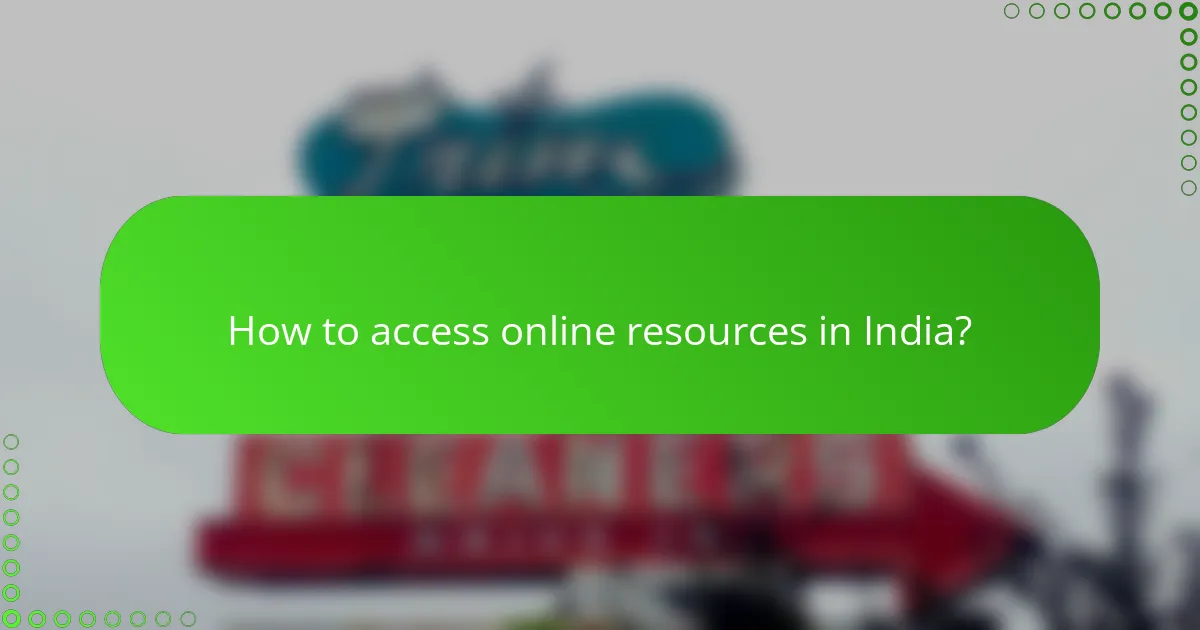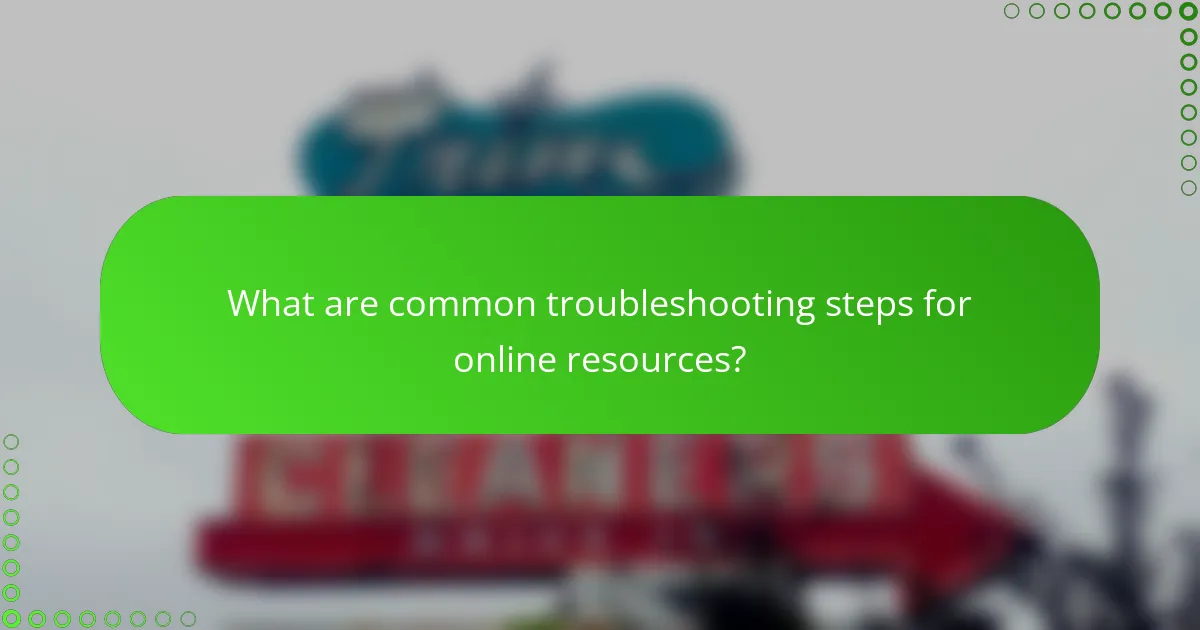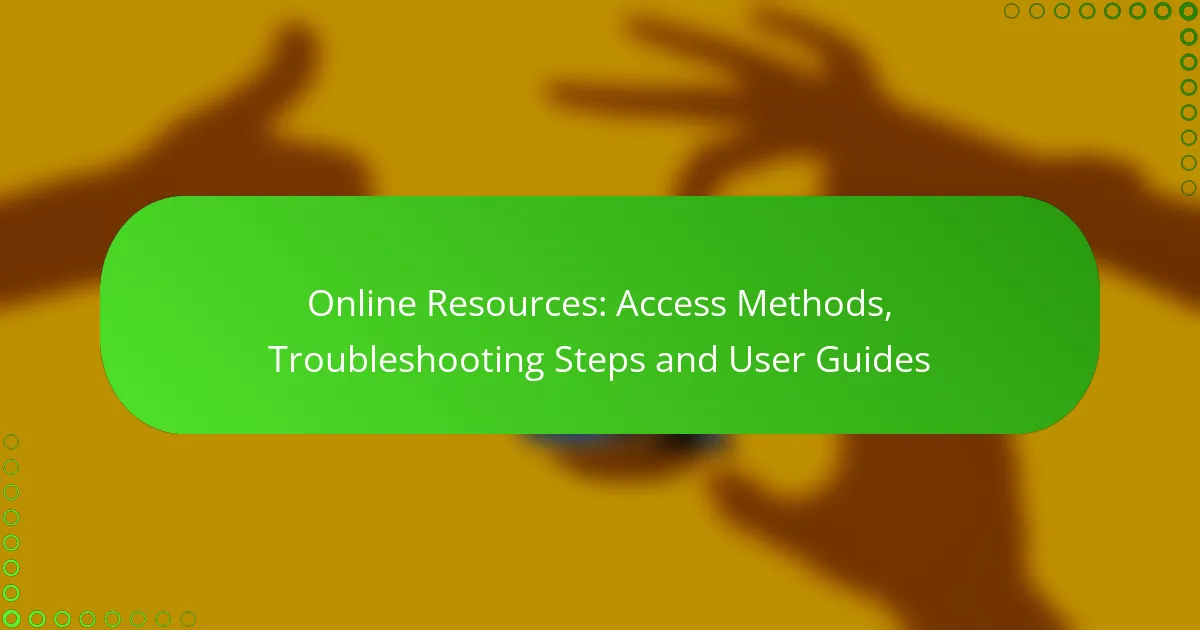Accessing online resources effectively requires understanding various methods such as mobile data, Wi-Fi hotspots, and institutional networks. Familiarizing yourself with common troubleshooting steps can help resolve access issues, while user guides for platforms like Google Drive and Dropbox offer valuable insights for maximizing your experience. By choosing the right access method and utilizing available resources, you can enhance your online activities significantly.

How to access online resources in India?
Accessing online resources in India can be done through various methods, including mobile data networks, Wi-Fi hotspots, public libraries, and educational institution networks. Each method has its own advantages and considerations, making it essential to choose the one that best fits your needs.
Using mobile data networks
Mobile data networks allow users to access online resources directly from their smartphones or tablets. Most mobile service providers in India offer 4G connectivity, which is generally sufficient for browsing, streaming, and downloading content.
When using mobile data, be mindful of your data plan limits to avoid unexpected charges. It’s advisable to monitor your usage, especially when accessing heavy content like videos or large files.
Connecting via Wi-Fi hotspots
Wi-Fi hotspots are widely available in urban areas, cafes, and public spaces, providing a convenient way to access online resources without using mobile data. Many establishments offer free Wi-Fi, but it’s crucial to ensure the network is secure before connecting.
To connect, simply select the Wi-Fi network from your device’s settings and enter any required passwords. Be cautious of public networks, as they can pose security risks; consider using a VPN for added protection.
Accessing through public libraries
Public libraries in India often provide free internet access to patrons, making them a valuable resource for accessing online materials. Many libraries also offer computers for public use, which can be beneficial if you do not have a personal device.
Check with your local library for specific access hours, available resources, and any membership requirements. Utilizing library resources can also connect you with knowledgeable staff who can assist with research and online navigation.
Utilizing educational institution networks
Educational institutions, such as schools and universities, typically offer robust internet access for students and staff. This access often includes specialized databases and online resources that may not be freely available elsewhere.
To use these networks, you may need to log in with your student or faculty credentials. Be aware of any usage policies, as institutions may have restrictions on certain types of content or activities while connected to their networks.

What are common troubleshooting steps for online resources?
Common troubleshooting steps for online resources include checking your internet connection, clearing your browser cache, updating browser settings, and restarting devices. These actions can resolve many access issues and improve overall performance.
Checking internet connectivity
To access online resources, a stable internet connection is essential. Start by ensuring that your device is connected to the internet, either through Wi-Fi or a wired connection. You can test connectivity by opening a different website or using a network diagnostic tool.
If you find that your internet is slow or intermittent, consider resetting your router or contacting your Internet Service Provider (ISP) for assistance. It’s also wise to check for any service outages in your area.
Clearing browser cache
Clearing your browser cache can resolve issues caused by outdated or corrupted files. Each browser has a different method for clearing cache, but generally, you can find this option in the settings menu under privacy or history.
After clearing the cache, refresh the page to see if the issue persists. Regularly clearing your cache can help maintain optimal browser performance and ensure you are viewing the most current version of a website.
Updating browser settings
Sometimes, outdated or incorrect browser settings can hinder access to online resources. Ensure that your browser is up to date, as updates often include security patches and performance improvements.
Additionally, check your privacy and security settings. Some settings may block certain content or scripts necessary for websites to function properly. Adjust these settings to allow access to the resources you need.
Restarting devices
Restarting your device can resolve many technical issues, including connectivity problems. A simple reboot can refresh system resources and clear temporary glitches that may be affecting your ability to access online resources.
If you are still experiencing issues after restarting, consider restarting your modem or router as well. This can help re-establish a stable internet connection and improve overall performance.

What user guides are available for popular online platforms?
User guides for popular online platforms like Google Drive, Dropbox, and Microsoft OneDrive provide essential instructions and tips for effective usage. These guides cover functionalities, troubleshooting, and best practices to enhance user experience.
Google Drive user guide
The Google Drive user guide offers comprehensive instructions on file storage, sharing, and collaboration. Users can learn how to upload files, organize folders, and share documents with specific permissions.
Key features include real-time collaboration on Google Docs, Sheets, and Slides, which allows multiple users to edit simultaneously. It’s important to understand the sharing settings to maintain privacy and control over your documents.
Common pitfalls include not managing storage limits effectively; Google Drive offers 15 GB of free storage, so users should regularly check their usage to avoid running out of space.
Dropbox user guide
The Dropbox user guide provides insights into file synchronization, sharing, and backup. Users can easily upload files and access them across devices, ensuring that important documents are always available.
Dropbox’s file recovery feature allows users to restore deleted files within a certain timeframe, which is crucial for data management. Users should be aware of their storage plan, as free accounts come with limited space, typically around 2 GB.
To maximize Dropbox’s functionality, consider using shared folders for collaborative projects, but be cautious about granting edit permissions to avoid unintended changes.
Microsoft OneDrive user guide
The Microsoft OneDrive user guide focuses on cloud storage integrated with Microsoft 365 applications. Users can store files, share them, and collaborate in real-time using tools like Word and Excel.
OneDrive offers 5 GB of free storage, with options to upgrade for additional space. Understanding the synchronization settings is essential to ensure that files are up-to-date across all devices.
Be mindful of the sharing options; using “view only” permissions can help prevent unauthorized edits. Regularly review shared files to manage access effectively and maintain security.

What criteria should be considered for selecting online resources?
When selecting online resources, consider factors such as the source’s reputation, accessibility features, and the relevance of the content to your needs. These criteria help ensure that the information you access is reliable, usable, and applicable to your specific context.
Reputation of the source
The reputation of an online resource is crucial for determining its reliability. Look for established organizations, academic institutions, or recognized experts in the field. Resources with positive reviews or endorsements from credible entities often provide more trustworthy information.
Check for indicators of quality, such as peer-reviewed content, citations, and the author’s credentials. Avoid sources that lack transparency or have a history of misinformation.
Accessibility features
Accessibility features are essential for ensuring that all users can effectively engage with online resources. Look for websites that comply with accessibility standards, such as the Web Content Accessibility Guidelines (WCAG). Features like text-to-speech options, adjustable font sizes, and keyboard navigation can significantly enhance usability.
Consider resources that offer multiple formats, such as audio, video, and text, to cater to different learning preferences. This inclusivity can make a substantial difference for users with disabilities or varying levels of tech proficiency.
Content relevance
Content relevance refers to how well the information meets your specific needs or interests. Evaluate whether the resource addresses your topic comprehensively and is up-to-date. Resources that are frequently updated or maintained are more likely to provide current and applicable information.
Utilize search filters to narrow down results based on your criteria, such as publication date or subject matter. This approach helps in finding the most pertinent resources quickly, saving time and effort in your research process.

How to ensure online resource security?
To ensure online resource security, utilize protective measures such as VPN services and two-factor authentication. These strategies help safeguard your data from unauthorized access and enhance your overall online safety.
Using VPN services
VPN services create a secure connection between your device and the internet, encrypting your data and masking your IP address. This makes it difficult for hackers and third parties to intercept your information, especially on public Wi-Fi networks.
When choosing a VPN, consider factors like speed, server locations, and privacy policies. Look for providers that do not log user activity and offer strong encryption standards. Popular options include NordVPN, ExpressVPN, and CyberGhost.
Always connect to the VPN before accessing sensitive online resources. Avoid free VPNs, as they may compromise your security by selling your data or lacking adequate encryption.
Enabling two-factor authentication
Two-factor authentication (2FA) adds an extra layer of security by requiring a second form of verification in addition to your password. This could be a text message code, an authentication app, or a biometric scan.
To enable 2FA, navigate to the security settings of your online accounts and follow the prompts to set it up. Most major platforms, such as Google, Facebook, and banking services, offer this feature. Using an authentication app like Google Authenticator or Authy is often more secure than SMS codes.
Make sure to keep backup codes in a safe place in case you lose access to your primary 2FA method. Regularly review your account security settings to ensure they are up to date and effective.







